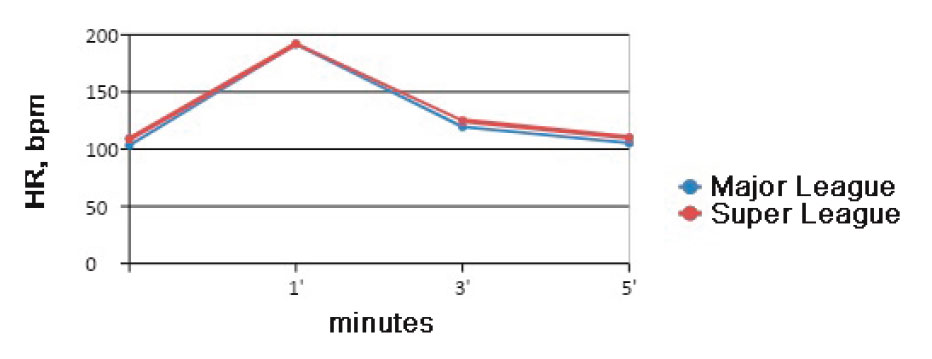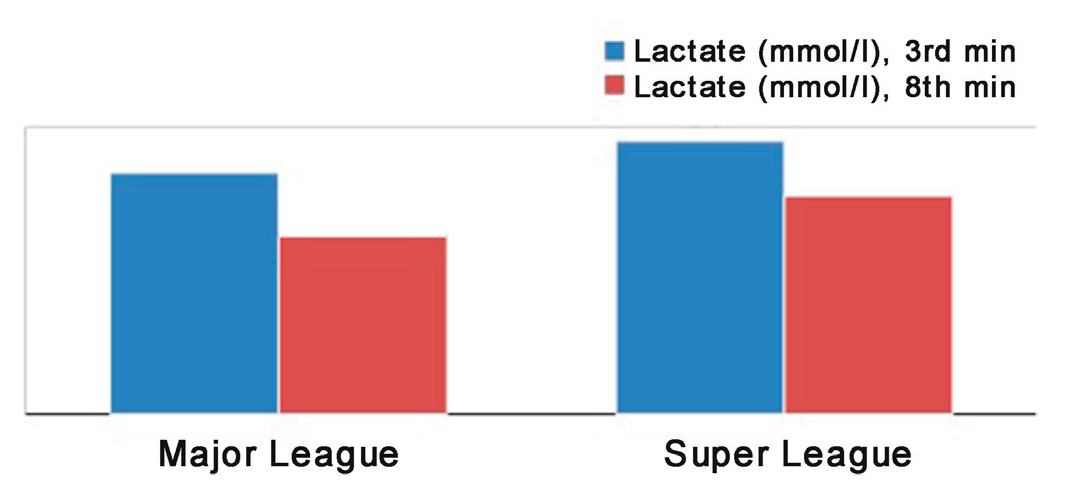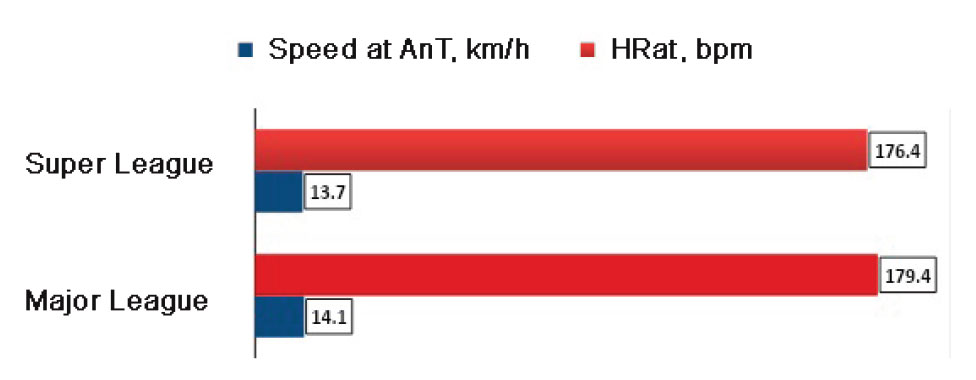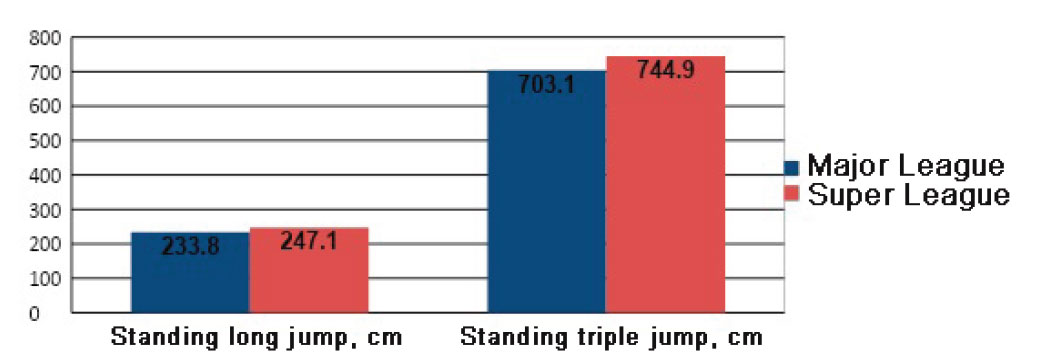Comparison of physical and physiological indicators in handball players of various training groups
ˑ:
PhD Qais B. Yasin1
PhD Bashar A.AL. Saleh1
PhD Rafat S.A. Eltibi1
PhD Qais M. Nairat1
PhD, Associate Professor I.V. Petracheva2
1Department of Physical Education, An-Najah National University, Nablus, Palestine
2Russian State University of Physical Education, Sport, Youth and Tourism (SCOLIPE)
Keywords: handball, milestone complete physical examination, physical indicators, physiological indicators.
Background. Nowadays, the issue of the athletic training system development is becoming more and more relevant. The achievement of high sports results depends on the relationship between the physical, tactical, technical, and psychological training. The intensity of a competitive struggle raised the quality standards for physical training, which reached such a level that further improvement of its effectiveness becomes a challenge. The primary importance of athletes' physical fitness is attributed to the use in the training process of large physical loads that require high functional potential [2].
Special functional training consists in the improvement of physiological mechanisms, which, in turn, ensure the efficiency of sports motor activity. The athletes' functional fitness is viewed as a complex, multi-component property of the body, with the perfect level of development of physiological mechanisms being the essence of the property, their readiness to secure, for the time being, the manifestation of all the qualities required for a specific sports activity, leading directly or indirectly to muscular activity, physical working capacity within the framework of a specific regulated motor act [3].
Objective of the study was to conduct a comparative analysis of the physical and physiological indicators in handball players of the Major and Super Leagues.
Methods and structure of the study. Sampled for the study were 36 handball players of the State Budget Professional Educational Institution "Moscow Secondary Special School of Olympic Reserve No. 2", Moscow Sport Committee, including 16 Major League athletes (aged 16-17 years) and 20 Super League ones (aged 17-21 years). The experiment was run in the competitive training period. The milestone complete physical examination involved the comprehensive assessment of the athletes’ morphological state, aerobic working capacity level, speed-strength abilities, dynamic and static stability level on the Biodex Balance System simulator.
Results and discussion. The results of the complex morphological study of the athletes revealed some significant differences between the handball players of different leagues in terms of several anthropometric indicators. The differences between the body mass, fat body mass, and muscle body mass rates in the Major and Super League handball players were statistically significant at p≤0.05. The difference between the growth rates in the Major and Super League handball players were insignificant at p≤0.05.
The results of the morphological study are presented in Table 1 as the arithmetic mean (![]() ) the standard deviation (
) the standard deviation (![]() ).
).
Table 1. Results of morphological study of handball players
|
Anthropometric indicators |
Major League handball players |
Super League handball players |
|
Height, cm |
187.2±6.51 |
188.3±10.0 |
|
Body mass, kg |
80.5±10.4 |
83.8±11.7 |
|
Fat body mass, % |
17.2±4.4 |
12.9±2.3 |
|
Muscle body mass, % |
49.6±2.5 |
53.1±1.9 |
The main indicator of the functional state of the body is the cardiovascular system functionality rate. Heart rate (hereinafter referred to as HR) is the most important cardiological criterion reflecting the degree of physiological stress. The competitive load rate can be determined by HR during the game and during the recovery period after the matchup.
The aerobic capacities (running speed on the aerobic threshold, threshold HR) of the handball players were determined in the HP/Cosmos treadmill test. The initial running speed was 7 km/h, followed by an increase of 0.1 km/h every 10 sec to the maximum. The average running speed of the handball players did not differ significantly, and the distance covered by the Super League handball players was lower (on average 3036.6±521.7 m) than that covered by the Top League handball players - 3143.3±428.7 m, indicating slight fatigue. Active recovery was taken into account against the background of a slow tempo (jam) on the treadmill for 7-8 minutes.
Throughout the experiment, the athletes' HR was recorded continuously. The data obtained showed that there were no pronounced differences in the maximum HR values between the handball players of the Major and Super League at p≤0.05. At an average speed of 16.2 km/h, HR ranged from 191.6±7.3 to 192.1±9 bpm, characterizing physical working capacity in the anaerobic energy supply mode. However, the HR dynamics in the recovery period differed statistically significantly. In the Major League handball players, HR during the first three minutes dropped to 119.5±6.4 bpm, while in the Super League athletes it reached 124.9±10.9 bpm only. These results can be explained by the fact that the age of the Major League handball players (16-17 years) affects the nature of the recovery processes. After the anaerobic exercises, their working capacity recovered faster than in the adult handball players of the Super League (17-21 years) (Fig. 1).

Fig. 1. Dynamics of HR in recovery period in Major and Super League handball players
We also registered the maximum blood lactate concentration rates (prior to the testing, every 3 minutes during the test, immediately after the testing, and in the recovery during the 3rd and 8th min) in the handball players. There was a slight increase in the blood lactate concentration (group average for the Super League handball group - 8.9 mmol/l, for the Major League handball players - 8.2 mmol/l). During the recovery period, the blood lactate concentration rate was higher in the Super League athletes during the 3rd min - 9.5 mmol/l (during the 8th min - 7.6 mmol/l) than in the Major League ones - 8.4 mmol/l (during the 8th min - 6.2 mmol/l). It can be concluded that the differences in the blood lactate concentration rates between the groups were statistically significant at p≤0.05 (Fig. 2).

Fig. 2. Blood lactate concentration rates (mmol/l) in handball players during the 3rd and 8th min
Anaerobic exchange threshold (AnT) - the HR level, at which the body changes from the aerobic to anaerobic mechanisms of energy supply - directly correlates with the physical fitness level and age. In the Major League handball players, the anaerobic threshold HR (HRat) amounted to 179.4±8.1 bpm and in the Super League ones - 176.4±8.8 bpm. This is due to the fact that junior handball players have a higher AnT rate as opposed to senior handball players. The differences in the HRat values between the Major and Super League groups were statistically significantly at p≤0.05 (Fig. 3).

Fig. 3. Anaerobic exchange threshold in handball players of various training groups.
It should be noted that the higher the AnT value, the more the load is performed through aerobic reactions. The improvement of aerobic capacity is primarily determined by the ability of various systems of the body (respiratory, cardiovascular, blood systems) to extract oxygen from the air and deliver it to the working muscles. To ensure the harmonious development of physical qualities, it is necessary to perform physical loads of various intensity during independent exercises [1].
In the game activity of handball players, the manifestation of strength abilities is dynamic, and often it is necessary to use both speed strength (ball throwing, ball handling, holding the ball with a hand, etc.) and explosive force (jump, dash). In addition, it is necessary to demonstrate strength repeatedly. Therefore, strength endurance is not the least important quality in handball training.
The results demonstrated by the handball players in the "Standing long jump" and "Standing triple jump" tests characterize the level of development of speed-strength qualities of the leg muscles when performing complex coordination actions. The Super League handball players passed the tests better - 247.1±18 (standing long jump, cm) and 744.9±44.4 standing (triple jump, cm), respectively. This proves that the differences in the "Standing long jump" and "Standing triple jump" test results between the Major and Super League groups were statistically significant (p≤0.05) (Fig. 4). Moreover, the ratio between the triple and long jump results was 3.0.
In general, there was a clear pattern, which was that the handball players demonstrated better results in the jumping exercises with the improvement of anthropometric rates.

Fig. 4. Speed-strength qualities of handball players of different training groups.
Overall vertical stability was assessed using the stability index (SI), which was lower in the Major League handball players (group average - 6.2±2.9) than in the Super League ones (group average - 7±3.6). The lower stability index, the higher the neuromuscular control level in the athletes, the better they hold the platform horizontally. The differences in the vertical stability rates between the Major and Super League athletes were statistically significant at p≤0.05 in favor of the Major League.
The percentage of time spent in zone "A", which was closest to the center of the target, was higher among the handball players of the Major League - 51.1±23.1% than among those of the Super League - 46.7±28%. These indicators characterize the effectiveness of the vertical posture control when performing a motor task, the maintenance of balance on a movable force plate.
The athletes' ability to purposefully control the movement of the center of gravity of their body while performing a motor task was evaluated in the stability limit test. The stability limit is the maximum angle to which an athlete can deviate without losing balance. The stability limit rate was on average slightly higher in the Super League handball players - 12.6 (Super League - 11.7), indicating the group’s ability to maintain balance.
The Major League handball players performed the test faster (on average 2:07 min:sec) than the Super League ones (2:34 min:sec). The quicker the test was performed, the fewer oscillations were recorded when the cursor moved.
Conclusions. The study found that the handball players of various training groups did not differ much in terms of their anthropometric indicators. There were no pronounced differences in the maximum HR values between the handball players of the Major and Super League at p≤0.05. At the same time, the dynamics of HR in the recovery period differed statistically significantly. These results can be explained by the fact that the age of the Major League handball players (16-17 years) affected the nature of the recovery processes. There was a slight increase in the average blood lactate concentration for the group of Super League handball players. The differences in the HRat values between the Major and Super League athletes were statistically significant at p≤0.05. HRat in the Major League handball players was higher than in the Super League ones. This was due to the fact that young handball players have a higher AnT rate as opposed to older handball players. To improve the aerobic capacity. it is necessary to increase the functional capacity of the circulatory, respiratory and blood systems of the body through regular targeted training. We identified a clear pattern, which was that, with the improvement of anthropometric rates, the handball players demonstrated better results in the jumping exercises. Therefore, particular attention should be paid to comprehensive physical training of handball players.
References
- Zheleznyak Yu.D., Portnov Yu.M., Savin V.P., Leksakov A.V. Sport games: Technique, tactics, training methods. M.: Akademiya publ., 2004. 520 p.
- Matveyev L.P. General sports theory. M.: Voenizdat publ., 1997. 230 p.
- Solopova I.N. Physiological basis of functional training of athletes. Volgograd: VSAPC publ. 2010. 346 p.
Corresponding author: Q.yaseen@najah.edu
Abstract
Objective of the study was to conduct a comparative analysis of the physical and physiological indicators in handball players of the major and super leagues.
Methods and structure of the study. Sampled for the study were 36 handball players of the State Budget Professional Educational Institution "Moscow Secondary Special School of Olympic Reserve No. 2", Moscow Sport Committee, including 16 Major League athletes (aged 16-17 years) and 20 Super League ones (aged 17-21 years). The experiment ran in the competitive training period. The milestone complete physical examination involved a comprehensive assessment of the athletes’ morphological state, level of aerobic working capacity, speed-strength abilities, level of dynamic and static stability on the Biodex Balance System simulator.
Results of the study. The handball players of various training groups did not differ much in terms of their anthropometric indicators. There were no pronounced differences in the maximum heart rate between the Major and Super League handball players at the significance level of p<0.05, while the dynamics of heart rate in the recovery period differed statistically significantly. There was a slight increase in the average blood lactate concentration for the group of Super League handball players.
Conclusion. The differences in the blood lactate concentration rates between the compared groups of athletes were statistically significant at p≤0.05. With the increase of their anthropometric indicators, the handball players demonstrated better results in jumping exercises, which must be considered in the process of physical training.


